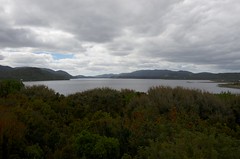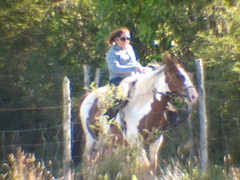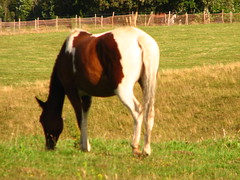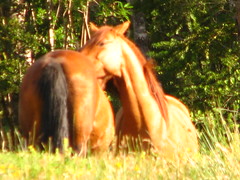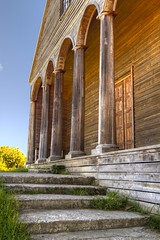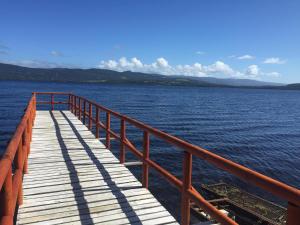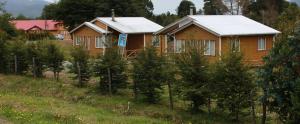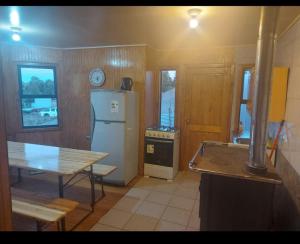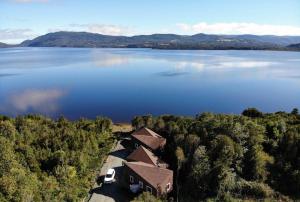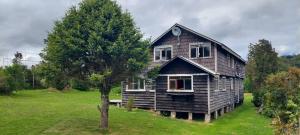Chiloé Archipelago
The Chiloé Archipelago (Spanish: Archipiélago de Chiloé, Spanish: [tʃiloˈe]) is a group of islands lying off the coast of Chile, in the Los Lagos Region. It is separated from mainland Chile by the Chacao Channel in the north, the Sea of Chiloé in the east and the Gulf of Corcovado in the southeast. All islands except the Desertores Islands form Chiloé Province. The main island is Chiloé Island. Of roughly rectangular shape, the southwestern half of this island is a wilderness of contiguous forests, wetlands and, in some places, mountains. The landscape of the northeastern sectors of Chiloé Island and the islands to the east is dominated by rolling hills, with a mosaic of pastures, forests and cultivated fields.
The archipelago is known within Chile for its distinctive folklore, mythology, potatoes, cuisine and unique architecture. The culture of Chiloé is the result of mixing of Huilliche, Spanish and Chono influences in centuries of isolation without much contact with the rest of Chile or the Western World. Its cool temperate climate, abundance of sea resources and large and lush forests have also played a major role in shaping life in the islands.
In colonial times, Chiloé was an important bulwark in the defence against Dutch and British incursions to Chile and Patagonia. The archipelago was the last Spanish possession in Chile, successfully repelling patriot invasions until 1826. In the 19th century, the archipelago was a starting point for the Chilean colonisation of Patagonia. Not only were major expeditions assembled in Chiloé, but thousands of Chilotes migrated to the sparsely populated mainland to work in sheep-raising estancias, as railway navvies, or to become independent settlers. Belief in witchcraft has been common in the archipelago, reaching such influence that in 1880 Chilean authorities put on trial warlocks said to rule the archipelago through a secret society.
Once considered an isolated and backward part of Chile, today the archipelago retains its rural character despite increased connectivity and the growth of cities such as Ancud, Castro and Quellón. Since the 1990s, salmon aquaculture and tourism have been important sources of revenue in the archipelago, complementing traditional activities such as fishing and small scale agriculture.
Geography
The Chiloé Province (Spanish: Provincia de Chiloé) includes all of the Chiloé Archipelago, except the Grupo Desertores islands, plus the Isla Guafo, for a total land area of approximately . The administrative center of the province is the city of Castro, while the episcopal see of the Roman Catholic bishopric is Ancud. The province of Chiloé is part of the Los Lagos Region (Región de los Lagos), which primarily consists of the Chilean lakes region on the mainland north of Chiloé; the administrative center of the region is Puerto Montt.
Chiloé Island is by far the largest island in the archipelago, at . It is roughly rectangular, with its long axis oriented from north to south. To the east of Chiloé Island lies the Sea of Chiloé, which contains most of the other islands in the archipelago. The Sea of Chiloé is a marginal sea separating Chiloé Island from Palena Province (also called Continental Chiloé). The main islands in the Sea of Chiloé are Quinchao, Lemuy, Tranqui, and Desertores Islands. To the northeast and southeast of the archipelago lie the Gulf of Ancud and the Gulf of Corcovado; the former is part of the Sea of Chiloé. Some southwest of Chiloé Island lies Guafo Island, the southernmost island of the archipelago.
Chiloé Island is separated from the Chilean mainland by the Chacao Channel in the north. Most of the good harbors are located on the island's northern and eastern shores. The eastern shore is marked by a series of peninsulas and inlets, notably Estero de Castro where the capital, Castro, is located. The western part of Chiloé Island, as well as the whole of Guafo Island, is hilly and covered by forests. The hills are subdivided into two north–south ranges, Piuchén and Pirulil, separated by the lakes Cucao and Huillinco. They contain the highest points in the archipelago and do not exceed . Depressions in the western forest are occupied by numerous small lakes and bogs scattered across the landscape.
A bridge to the mainland is planned for the archipelago, despite opposition from some residents who fear pollution and habitat destruction. The Chacao Channel bridge would replace the ferry that connects the village of Chacao, Ancud Comuna, on Route 5 at the northern end of Chiloé Island, across the Chacao Channel with the village of Pargua, Calbuco Comuna, on the mainland.
History
Pre-Hispanic period
The Chiloé Archipelago may have been populated as early as 12,000 to 11,800 BC, according to archaeological discoveries in Monte Verde, located less than north of the main island. Chiloé's first ethnically identifiable inhabitants are believed to be the Chonos, a seafaring nomadic people. This has led to the assumption that Chonos were the people who left behind most of the abundant shell middens (chonchales) of the Chiloé Archipelago, yet this claim is unverified.
There are various placenames in the Chiloé Archipelago with Chono etymologies, despite the main indigenous language of the archipelago at the arrival of the Spanish being Huilliche. A theory postulated by chronicler José Pérez García holds that the Cuncos settled in Chiloé Island in Pre-Hispanic times as consequence of a push from more northern Huilliches, who in turn were being displaced by Mapuches. Cuncos, Huilliches and Mapuches all belong to the wider Mapuche macro-ethnicity.
The Cuncos, who were a coastal people, arrived from the mainland north of Chiloé and settled on the eastern shore of the Isla Grande, practicing horticulture and fishing. Some accounts mention the northern half of the Chiloé Island as Cunco territory.
It can be said that Chiloé was a contact zone between the Mapuche (Araucanian) world and the southern tribes.
Spanish colony (1567–1826)
The main island was first discovered by Spaniards in 1553 by Francisco de Ulloa. In 1567, the island was conquered for Spain by Captain Martín Ruiz de Gamboa, who was at the head of an expedition of 110 Spaniards. Gamboa named the islands Nueva Galicia (New Galicia) in honor of the place of origin of Rodrigo de Quiroga who as governor had organized the expedition. Gamboa established a settlement at Castro in 1567, which later became the seat of a Jesuit mission and was capital of the province until the founding of Ancud in 1768.
In early colonial times, the Spanish introduced a number of Old World crops and agricultural systems. Some of these cultivars and systems ended with poor results, yet the introduction of pigs and apple trees proved a success. Pigs benefited from abundant shellfish and algae exposed by the large tides. Wheat came to be grown in lesser quantities compared to the native potatoes, given the adverse climate.
During the first years of the colony, the spiritual labour was carried out by Mercedarians and Franciscans. The first Jesuits arrived in 1608 and founded in 1612 the first church in Castro. Because of the scattered population living in different islands, the Jesuits established a circular mission system with numerous chapels and churches. The priests of the circular mission travelled from September to May to the scattered missions using dalcas. The Jesuits established a collegium in 1660 in Castro. By 1767, when the Society of Jesus was suppressed, there were 13 Jesuit missioners and 79 chapels. From 1771 onwards, the Franciscans took over the functions of the Jesuits in Chiloé.
As result of a corsair and pirate menace, Spanish authorities ordered to depopulate the Guaitecas Archipelago south of Chiloé, to deprive enemies of any eventual support from native populations. This was in line with the ideas of Governor Antonio Narciso de Santa María, who thought the Spanish should concentrate efforts in defending Chiloé Island. Depopulation of Guaitecas Archipelago meant the indigenous Chono population settled in the Chiloé Archipelago, where they became gradually assimilated.
Ancud was made capital of the Chiloé in 1767. In 1784, Chiloé Island was made a direct dependency of the colonial viceroyalty of Peru as a consequence of the Bourbon reforms, while continental Chile was a captaincy-general within the viceroyalty. The change of capital and shift to dependency corresponded to a new strategic view of the Chiloé Archipelago. While initially Chiloé was viewed by Spaniards as a colony rich enough to conquer, it later became a problematic region due to its geographical isolation from mainland Chile and the War of Arauco in the mainland. Chiloé Island was largely exempt from the turmoil that affected the Chilean mainland due to conflicts with Huilliches and Mapuches, but was notably affected in 1712 by a large Huilliche rebellion.
During colonial times, Chiloé served as base for a series of explorations towards the interior of Patagonia as well as to its channels. The Jesuit Nicolás Mascardi crossed the Andes through the Vuriloche Pass and set up a mission on the shores of Nahuel Huapi Lake in 1670. The Jesuits established in Chiloé brought Chonos from islands south of Chiloé to settle in the archipelago, which led to acculturation with the Spanish-Huilliche of the island.
Royalist stronghold (1812–1826)
Unlike the central region of Chile where a long war of independence resumed after a Spanish reoccupation, Chiloé never joined the Patria Vieja (Old Republic), and its population rather than conspiring to overthrow the local Spanish administration gave it wide support. From 1812 and on, men from Chiloé would be enlisted as soldiers and sent to fight in Chile, Bolivia and Peru for the royalist cause. In December 1817, the island became the last stronghold of Spanish royalists (together with Valdivia) fleeing from the Chilean mainland. A Chilean expedition led by Thomas Cochrane, 10th Earl of Dundonald disembarked 6…
Hotels Chiloé Archipelago
Looking for places related to Chiloé Archipelago?
Those are other destinations to find places related to Chiloé Archipelago:
- Osorno
- Tronador
- Todos los Santos La…
- Llanquihue Lake
- Calbuco
- Los Alerces Nationa…
- Chaitén
- Canal de Tenglo
- Church of San Franc…
- Chiloé Archipelago
- Churches of Chiloé
- Peulla
- Teatro del Lago
- Guafo Island
- El Tepual Airport
- Cochamó Valley
- Church of Our Lady …
- Iglesia del Sagrado…
- Parque Tantauco
- Mall Paseo Costanera
- Casa Opitz
- Islotes de Puñihuil…
- Apagado
- Llanquihue National…



